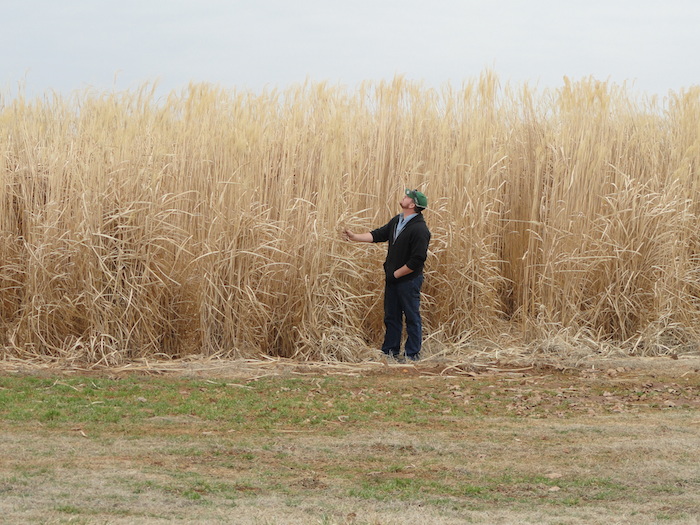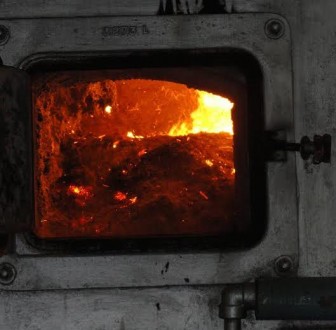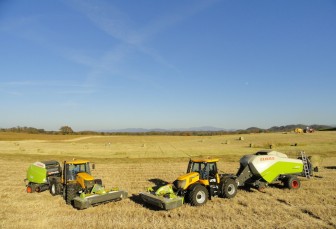
Tom Schwartz of FDC Enterprises discusses the use of dedicated energy crops with a U.S. Fish and Wildlife Service official. Image: FDC Enterprises
Birds stand to gain valuable grassland habitat if the appetite to balance conservation and biofuel production continues gaining support in scientific circles.
But developing a business case for biofuel production that meets the needs of the birds with the current national renewable standards isn’t easy.
A recent study by the University of Wisconsin-Madison looked at how conserving grasslands for birds could also serve the economic needs for biofuels.
The study measured vegetation and the number and distribution of species to assist in the biofuel policy debate, said Peter Blank, ecologist and lead author of the study.
Red-winged blackbirds, song sparrows and common yellowthroats were among the species that responded to changes in the landscape.
Lands with more flowering plants, such as forbs and wildflowers, tended to have more birds, said Blank.
But there were trade-offs when the researchers weighed if the plants that the birds favored were also the best for producing biofuels.
They found that fields with the most biomass that could be turned into fuel may be the most profitable, however, “they don’t provide the best habitat features for birds,” Blank said.
The study is part of a movement among scientists to investigate management practices that reconcile the needs of industry and those of conservation and wildlife communities.
Conservation lands are already known to benefit ecosystems, including wildlife habitat and the reduction of soil erosion. But they have not provided fuel.
In the federal Conservation Reserve Program, farmers are paid to plant grassland species that improve environmental health and quality instead of planting crops that are more profitable to them.
These lands also hold potential to provide the raw materials for bioenergy.
But using the conservation land at a scale large enough to produce biofuels is a problem because annual harvest of these lands has penalties, said Carol Williams, who coauthored the study.
Currently, landowners’ rental rates are reduced by as much as 25 percent if Conservation Reserve Program lands are routinely harvested.
Instead of growing the raw materials for biofuel on these lands, scientists look for sustainable energy alternatives in grass mixtures.

Miscanthus, a fast-growing group of perennial grasses used for biofuels. Image: FDC Enterprises
The hope is that grass mixtures can be managed to meet the needs of the energy industry, in quantity and quality, said Williams.
“If there’s a strong business case for growing raw materials that provide both fuel and wildlife habitat, then it’ll happen,” she said.
But the production of biofuels is both policy and market driven.
When biofuels cannot beat the price of natural gas or petroleum, “sustainability becomes the platform by which you make the sale,” said Tom Schwartz, vice president of marketing and certified wildlife biologist for FDC Enterprises, a national bioenergy and conservation-service provider.
Putting a price on sustainability is difficult. It is ecologically profitable to create wildlife habitat, but harder to price economically.
Despite subsidized production, there’s still a limited market for cellulosic or grass-based biofuel, said Blank.

A biomass boiler. Image: FDC Enterprises
A 2011 plan to retrofit a coal-based University of Wisconsin-Madison power plant to include a biomass boiler was scrapped in favor of a natural gas plant, a cheaper alternative that’s still more efficient than coal.
“Making the case for biofuel depends on the type of fuel someone is trying to displace, and if it comes down to just price, it’s not going to work,” said Schwartz.
Ethanol, made mostly from corn byproducts, supplies the largest renewable energy market in the country, converting nearly 15 billion bushels of corn into fuel last year. And biodiesel, made primarily from soybeans, makes up most of the remainder.
Whether corn-ethanol or grass-based biofuel, pricing structures for the purchase of power from renewables vary from state to state.
“The U.S. Department of Energy and the USDA create opportunities to fund innovation in business and technology,” said Williams.
“But farmers or corporate investors rarely get a return on investment because of the low buyback rate for renewables,” she said.
Researchers continue to investigate grass-based management practices that reconcile the need for habitat and fuel, but implementing such a plan does not yet have political support.
“Policy changes are what will drive this market into a larger opportunity, allowing harvest and placing some monetary value on ecosystem services like habitat,” said Schwartz.
The UW-Madison study, which stemmed from the failed biofuel retrofit, realizes the potential value of grassland bird habitat.
Scientists looked at plants that can deliver the yield industry demands and in a way that reduces variability, while still delivering ecosystem service like grassland bird habitat, Williams said.
Researchers selected 30 fields in Wisconsin to represent what could be used to grow the raw materials for biofuel.
They compared the costs and the yield for making biofuels from diverse grass stands and with corn.

Balers cut, compress and rake grass biomass for fuel production. Image: FDC Enterprises.
Unlike corn, which requires annual planting, the perennial grass fields need only be planted once. That saves on energy costs, Blank said.
“Grassland bioenergy can be a win-win situation, providing biomass, a crop producing financial gains for farmers and bird habitat, which is not true of corn,” he said.
But the future source of biofuels remains uncertain.
A movement from making biofuels from a single crop system like corn to mixed crops like perennial grasslands “will take political will, change of environmental perception, change of markets and a new way of looking at farms,” Blank said.